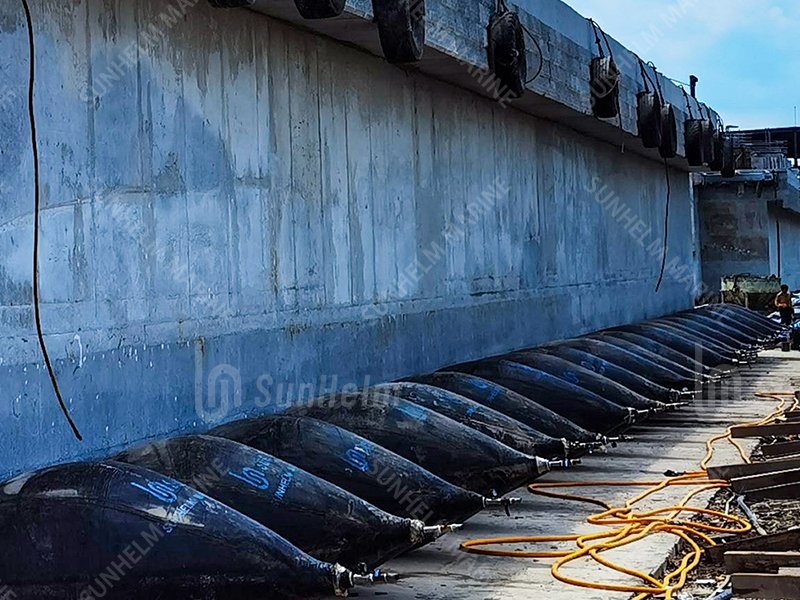Launching ships using marine airbags is a cost‑effective, flexible and relatively safe method—yet it’s not without risks. As industry leaders at Sunhelm know, mastering the art requires solid know‑how and attention to detail. Here are 10 Pro Tips for Launching Ships with Marine Airbags Safely and Efficiently—designed for shipyards eager to optimize performance and ensure everyone goes home safe.
🌊 Why this matters now
A recent incident at a small yard nearly ended in disaster because water levels were misread, airbags were arranged improperly, and sharp debris punctured the bags at the last minute. Launching ships with airbags may seem straightforward, but worst-case scenarios—like burst airbags, tipping vessels, or hull damage—can happen fast. In busy shipyards where Sunhelm operates, every delay costs money and reputation. You can’t compromise on safety or efficiency.

10 Pro Tips for Safe & Efficient Ship Launching
- Choose the Right Marine Airbag Specs for Vessel Size
Select marine airbag diameter, length and layer‑count based on ship length, beam, and weight. For example, airbags should exceed the height of keel blocks and use a 15–20% weight safety margin. - **Calculate Required Number & Spacing Precisely**
Use ISO‑based formula:
N=K1QgCbRLdN = K_1 \frac{Q g}{C_b R L_d}N=K1CbRLdQg
Add 2–4 spare airbags, and ensure spacing meets guidelines:
L/(N−1)≤6kL/(N−1) \le 6kL/(N−1)≤6k and ≥ πD/2+0.3\pi D/2 + 0.3πD/2+0.3. - Prepare & Protect the Slipway
Clear debris, fill uneven spots, and consider rubber mats or steel plates if a gravel ramp is unavoidable. - Thoroughly Inspect Airbags Before Use
Look for cracks, abrasions, valve integrity, and airtightness. Repair even minor leaks—pressure testing is essential. - Inflate to Correct Working Pressure
Maintain minimum ~50–80 kPa and stay within the rated PSI range. Avoid over-inflation to prevent bursting. - Arrange Airbags for Balanced Load Distribution
Use a linear, staggered, or dual‑line setup depending on ship width. Position center‑to‑center and side‑to‑side alignment carefully. - Reinforce Holding & Winch Systems
Secure the vessel with dual braking (hydraulic + manual) systems, ground anchors, winches ,and safety backup lines. - Monitor Water Levels & Timing Closely
Use a survey stake pole rather than relying solely on tidal charts. Launch at a higher tide for safer hull entry. - Control Descent for Smooth Water Access
Gradually reduce the ship launching airbags’ pressure and gently ease the vessel into water while winching—this helps prevent sudden shifts in the center of gravity. - Recover Ship Launching Airbags and Inspect After Launch
Deflate fully, clean, dry, and store in covered, cool spaces. Check for damage and schedule regular maintenance.
Quick‑Hit Snippets
“Choose airbags sized to exceed keel‑block height and include ≥15 % safety margin.”
“Use ISO formulas to determine the number of airbags, then add 2–4 spares for emergencies.”
“Launch at higher tide and gently deflate airbags while winching for smooth vessel rollout.”
Why Stick Around?
Because once you nail these steps, launching goes from nerve-wracking to second nature. You boost productivity, cut overhead, and protect both crew and asset—the perfect win for shipyards like Sunhelm’s.
FAQ
- How are marine airbags spaced during a ship launch?
Using specified formulas (see tip 2) that reference ship bottom contact length, diameter, and ship type. - What PSI should the ship launching airbags be inflated to?
Generally 50–80 kPa minimum and within the manufacturer’s PSI range; never exceed rated working pressure. - When is the best time to launch a ship using airbags?
Close to high tide, using real‑time water‑level stake readings—not just tidal tables. - How do you protect airbags from slipway debris?
Thoroughly clean, fill pits, or use rubber or steel mats to avoid punctures. - What happens if an airbag bursts during launch?
That’s why you add spare airbags, double-secure winches, and control tethering—to prevent catastrophe.


